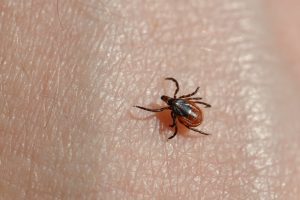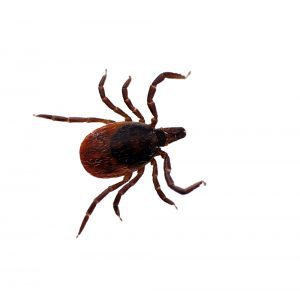FEWER LYME DISEASE TICKS THIS YEAR? IS IT A TREND?
By Chris Williams on September 19, 2018.

Scientist studies Blacklegged tick. Shutterstock.
It sounds like good news. Scientists at the Maine Medical Center Research Institute say that early results from blacklegged tick surveys in Maine, New Hampshire, and Massachusetts during the summer have turned up fewer of the ticks that transmit Lyme disease. Likewise, the number of cases of Lyme disease have also declined this summer.
Experts are attributing it to the extra hot and dry weather. While we might like to think that the conditions have killed off many ticks, researchers know from previous experience that this is not likely the case. Instead, when conditions become unfavorable, blacklegged ticks simply wait it out. They go into a kind of diapause, not quite hibernation. They burrow under leaves or into dirt and wait.
THERE’S PLENTY MORE TICK SEASON TO COME

Blacklegged tick on skin. Shutterstock.
Even though reported Lyme disease cases in the Northeast seem to have declined this summer, experts warn not to let your guard down. Celebrations are also premature, as they know from experience. Tick researchers in Maine learned their lesson in 2016 when they theorized that low tick numbers into late August might have been the result of a summer drought that killed off many ticks or so interfered with the disease life cycle that Lyme cases would decline. Alas, the ticks reappeared and Lyme quickly rebounded in the fall. After a slow start, 2016 ultimately set records for number of cases reported.
The same could happen this fall, especially if it proves to be a wet one. That’s because ticks like high humidity and periods of soaking rain rather than spotty showers. They are less interested in looking for and attaching to host animals when it’s too dry.
WARMER WINTERS FAVOR THE TICKS
Of course, drought can be very regional. While tick numbers are reportedly down for now in Massachusetts and New Hampshire in general, it doesn’t mean that the same is true for your little corner of the world. Ticks may be very active in your backyard at this very moment.

Close up of Blacklegged tick. Shutterstock.
We also know from recent research that blacklegged ticks are surviving and feeding and transmitting disease much later in the season than they used to, thanks to warmer winter temperatures (see Where Do Ticks Go in the Winter?). Extreme cold may slow them down but anytime the temperature is above 40 degrees, blacklegged ticks can become active and bite. The warmer winters are also allowing more ticks to survive the winter and expand their range ever northward.
Tick bite prevention (Protecting Your Family From Ticks – Advice From the Pros) and tick management (Take Steps to Keep Ticks Out of Your Yard) are now year-round concerns for everyone.